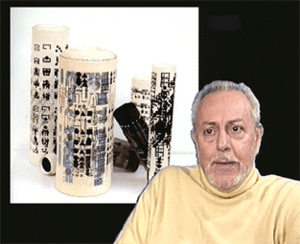Constantin Xenakis facts for kids
Constantin Xenakis (Κωνσταντίνος Ξενάκης) was a Greek artist who lived mainly in France. He was born on December 28, 1931, and passed away on June 6, 2020. His artwork was unique because it often featured different types of writing and symbols. He used letters from the Hebrew, Greek, Phoenician, and Arabic alphabets. He also included everyday symbols like traffic signs, ancient Egyptian hieroglyphs, and even mathematical and chemical symbols in his art.
Contents
Life of an Artist
Constantin Xenakis was born in Cairo, Egypt, on December 28, 1931. He moved to Paris, France, in 1955 and spent most of his life there. He was recognized for his artistic talent and received several important awards. In 1986, he was made a Chevalier de l' Ordre des Arts et des Lettres. This is a special honor in France for people who have contributed a lot to arts and literature. In 1996, he won the Prix Delmas from the French Academy of Fine Arts. A community center in Fameck, France, even opened a special room named after him in 1991. His artworks are kept in important places like the National Gallery of Greece and the Macedonian Museum of Contemporary Art. Constantin Xenakis died in 2020 at the age of 88.
What Kind of Art Did He Make?
Xenakis created many different kinds of art, including paintings, sculptures, and special art installations. His work often explored ideas about communication and how we use symbols in our daily lives.
Notable Art Projects
- In 1969, he created a show called "EK-STASIS." It featured his moving sculptures, electronic music, and mime performances.
- In 1982, he helped create "La grande journée," a co-production for television. He designed the sets for this project.
- In 1985, he designed large relief sculptures and ceramic paths for a sewage pumping station in Crosne, France. These designs covered a huge area of 670 square meters and used many of his unique symbols.
Where His Art Was Shown
Constantin Xenakis had many solo exhibitions around the world. These shows allowed people to see his unique art up close.
Important Exhibitions
- In 1969, he had a show called "Espace a Reflexion" in Sweden.
- The Malmö Museum in Sweden featured his work in 1970.
- He also had exhibitions in Athens, Greece, at the Goethe Institut in 1971.
- In 1981, a major exhibition called "Constantin Xenakis: 15 Ans d'Art Sémiotique" (15 Years of Semiotic Art) was held in France. It showed his paintings and environmental art.
- His art traveled to Asia in 1985, with shows in Seoul, South Korea, and Tokyo, Japan. He also had an exhibition at the Museum of Modern Art in Taipei.
- A big retrospective show, "The return of the artist," took place in Alexandria, Egypt, in 1996. It looked back at his art from 1958 to 1996.
- In 1997, he created a large installation called Le Livre de la Vie, Chapitre B (The Book of Life, Chapter 2) in Thessaloniki, Greece. This was part of the "Thessaloniki Cultural Capital of Europe" events.
- His work continued to be shown in Greece, Spain, and France in the 2000s, including at the Herakleidon Museum in Athens in 2006.
See also
- List of concrete and visual poets


